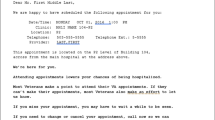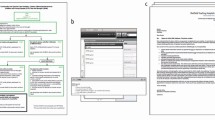Abstract
Community health center clinics that rely on scheduled appointments lose revenue and time when patients do not keep their appointments. Various approaches have been used to improve the rate of patient appointments kept. This article provides a model intervention program developed by a quality improvement committee at a Northwest Ohio community health center that is credited with significantly reducing rates of patient failure to keep scheduled medical and dental clinic appointments. The approach of this intervention program is different from others in that it was primarily designed to help patients learn how to become part of the solution to the problem. Community health center staff accomplishes this through engaging patients in a respectful and courteous manner and helping them understand the importance of their involvement in maintaining an efficient scheduling process to benefit all patients. Data collected from outpatient appointment records before and after implementation of the program indicate that missed appointments dropped to less than half the pre-intervention rate.
Similar content being viewed by others
References
Capko, J., & Capko, J. (2007). The price you pay for missed appointments. The Journal of Medical Practice Management, 22(6), 368.
Moore, C. G., Wilson-Witherspoon, P., & Probst, J. C. (2001). Time and money: Effects of no-shows at a family practice residency clinic. Family Medicine, 33(7), 522–527.
Pesata, V., Palliaga, G., & Webb, A. A. (1999). A descriptive study of missed appointments: Familie’s perceptions of barriers to care. Journal of Pediatric Health Care, 13(4), 178–182.
Tuso, P. J., Murtishaw, K., & Tadros, W. (1999). The easy access program: A way to reduce patient no-show rate, decrease add-ons to primary care schedules, and improve patient satisfaction. The Permanente Journal, 3(3), 68–71.
Garuda, S. R., Javalgi, R. G., & Talluri, V. S. (1998). Tackling no-show behavior: A market-driven approach. Health Marketing Quarterly, 5(4), 25–45.
Sharp, D. J., & Hamiliton, W. (2001). Non-attendance at general practices and outpatient clinics: Local systems are needed to address local problems. British Medical Journal, 323(7321), 1081–1082.
Macharia, W. M., Leon, G., Roewe, B. H., Stephenson, B. J., & Haynes, R. B. (1992). An overview of interventions to improve compliance with appointment keeping for medical services. The Journal of the American Medical Association, 267(13), 1813–1817.
Hixon, A. L., Chapman, R. W., & Nuovo, J. (1999). Failure to keep clinic appointments: implications for residency education and productivity. Family Medicine, 31(9), 627–630.
Guse, C. E., Richardson, L., Carle, M., & Schmidt, K. (2003). The effect of exit-interview patient education on no-show rates at a family practice residency clinic. The Journal of the American Board of Family Practice, 16(5), 399–404.
Bean, A. G., & Talaga, J. (1992). Appointment breaking: causes and solutions. Journal of Health Care Marketing, 12(4), 14–25.
LaGanga, L. R., & Lawrence, S. R. (2007). Clinic overbooking to improve patient access and increase provider productivity. Decision Sciences, 38(2), 251–276.
Johnson, B. J., Mold, J. W., & Pontious, J. M. (2007). Reduction and management of no-shows by family residency practice exemplars. Annals of Family Medicine, 5(6), 534–539.
Smith, C. M., & Yawn, B. P. (1994). Factors associated with appointment keeping in a family practice residency clinic. The Journal of Family Practice, 38(1), 25–29.
Maxwell, S., Maljanian, R., Horowitz, S., Pianka, M. A., Cabrera, Y., & Greene, J. (2001). Effectiveness of reminder systems on appointment adherence rates. Journal of Health Care for the Poor and Underserved, 12(4), 504–514.
Hardy, K. J., O’Brien, S. V., & Furlong, N. J. (2001). Quality improvement report: Information given to patients before appointments and its effect on non-attendance rate. British Medical Journal, 323(7324), 1298–1300.
Lacy, N., Paulman, A., Teuter, M., & Lovejoy, B. (2004). Why we don’t come: patient perceptions on no-shows. Annals of Family Medicine, 2(6), 541–545.
Author information
Authors and Affiliations
Corresponding author
Rights and permissions
About this article
Cite this article
Schmalzried, H.D., Liszak, J. A Model Program to Reduce Patient Failure to Keep Scheduled Medical Appointments. J Community Health 37, 715–718 (2012). https://doi.org/10.1007/s10900-011-9505-0
Published:
Issue Date:
DOI: https://doi.org/10.1007/s10900-011-9505-0




